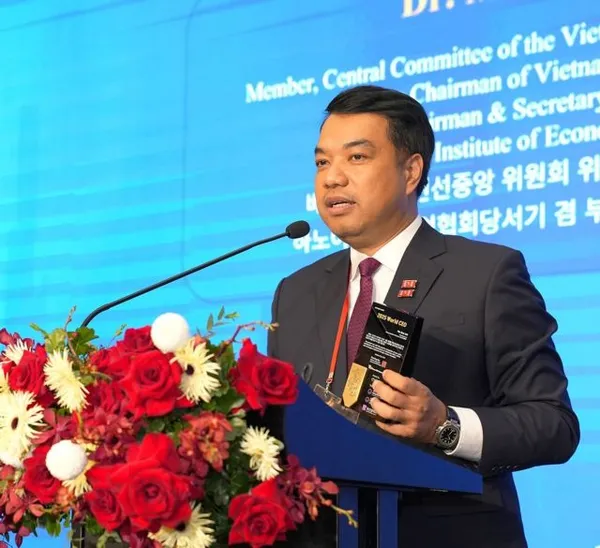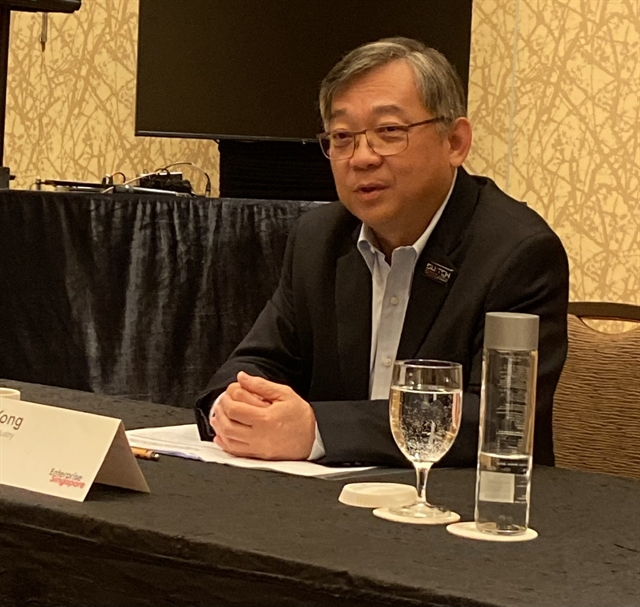 Talking Shop
Talking Shop

 |
| Gan Kim Yong, Singapore’s Minister for Trade and Industry. VNS Photo Vũ Hoa |
Bilateral trade relations between Việt Nam and Singapore in digital and green economy are expected to further deepen. Gan Kim Yong, Singapore’s Minister for Trade and Industry, talked to media about the two countries’ co-operation in the emerging areas at the sidelines of the Singapore Week of Innovation and Technology 2023 held recently.
This February, Việt Nam and Singapore signed a Memorandum of Understanding (MoU) on green and digital economic partnership to deepen the bilateral co-operation in the two emerging areas. So how have the two countries implemented so far? What is your expectation from the MoU?
This is a very important MoU for us. Digitalisation remains a key area for progress and development. It is better for us to work together both bilaterally as well as regionally, even within ASEAN where we have the digital economy framework. This involves providing a framework and a basis for co-operation among countries. But we also recognise that not all countries will be at the same level of progress in terms of digitalisation. Therefore, there is a diversity among ASEAN members in terms of readiness and development. We are working together, but we also encourage members to engage in bilateral collaboration to see how we can push ahead with co-operation in the digital economy
One area that we are working with Việt Nam and other countries is how we can ensure data flow across borders, how we can make sure that digital systems are interoperable, how we can link up with digital payment system and how we can use digital means to facilitate trade. For example, electronic bills of lading is something that's very critical for international trade. We want to strengthen digital adoption to encourage more trucks. We have the ASEAN Singapore Window initiative to allow for trade and economic integration among our regional trading partners through a common database. This can only be done if information is digitalised.
On green economy, this is very new and emerging area. We want to encourage co-operation on various projects. One of the projects that we are hoping to make progress on is electricity export from Việt Nam to Singapore. Perhaps 10 years ago, nobody thought this is possible. Now we are in serious discussion on how we can have green energy generated from Việt Nam and sold to Singapore.
We are also looking at the possibility of low carbon solutions, for example reforestation and how we can promote decarbonisation of industries. These projects will then create carbon credits and help countries to achieve their zero carbon national commitment. How this works is through carbon trading, where countries can invest in reforestation project in Singapore, Việt Nam and other countries. It's all about win-win proposition and working together to develop many of these sustainability related solutions for both countries.
We're also very keen to work together to accelerate technological developments in the green space, one area being hydrogen technology. The whole world is very keen on the development of hydrogen technology but doing so is challenging. While it is possible to use hydrogen for industry and for power generation, transportation remains a problem. So I think digitalisation and the green economy are some of areas of collaboration between Singapore and Việt Nam.
The development of startup ecosystem and the supporting government policies contribute to the success of Singapore’s innovation landscape. Could you share some lessons that countries including Việt Nam can learn from Singapore?
We can learn a lot from Việt Nam. Việt Nam is a very innovative country and fast developing economy. I think your companies have been growing very rapidly. One lesson that we've learned is keeping our market open. This enables Singapore to remain open to ideas, investments and global talent. Many of our innovative projects are not done just in Singapore but in close collaboration with partners such as the US, Việt Nam and China. There is immense R&D talent worldwide. So I think it is important for us to have a system to allow researchers and our scientists to tap into the global network of innovation. This will help us develop our own capabilities and attract more R&D to benefit companies in varying stages.
With all investments, you need to also have risk tolerance to be able to accept that some will fail. It's always the knowledge that you will gain in the process of a failed project that can be valuable in the next. At some point in time, you will have a successful project. So we need to find a way to support R&D efforts, at the same time have a system to capture the value of R&D efforts even if the project itself does not succeed. By doing so, you're able to capture the value of that knowledge gained and apply them to the next project to maximise the chances of success.
Many of startups in Singapore said that they are looking to Việt Nam as their next market of choice. So how is the Singapore government supporting them in expanding their businesses to Việt Nam and building an innovation ecosystem between the two countries?
We have our Market Readiness Assistance (MRA) scheme to support our enterprises expand into overseas markets, including Việt Nam. Enterprise Singapore, our government agency driving enterprise development, also has overseas offices that will be able to help them set up in these markets and collaborate with overseas partners. We are very happy to support our enterprises to collaborate with their counterparts in Việt Nam, across areas such as technology and agriculture. VNS




